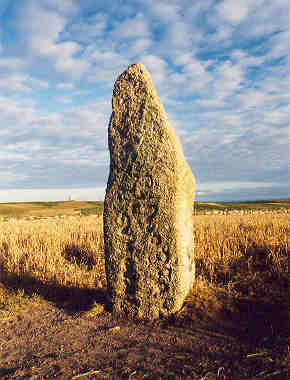The moors of West Penwith sloping southwards towards Mounts Bay have more than their fair share of archaeological treasures. This fragile moorland and its prehistoric remains have in the modern period been threatened first by mining, then by industrialized farming methods and finally by the pressures of tourism and, according to some, by unsympathetic environmental ‘management’.
Here we can find within a small area Neolithic stone circles, Bronze Age round houses and field systems, Iron Age forts, settlements– the most impressive being the second century courtyard village at Chysauster – and standing stones from various eras.
A short walk across a now largely deserted landscape, passing several derelict nineteenth century farm buildings and cottages, brings us to the Men Scryfa. Standing in the middle of a field, this might be mistaken for a scratching post put up by a farmer for the relief of his cattle. But on it we can just make out the words Rialobrani Cunovali fili – Rialobranus (or royal raven), son of Cunavolus. Men Scryfa in Cornish means ‘writing stone’ and the Latin script dates from somewhere between the fifth and seventh centuries, written on what was originally a Bronze Age standing stone.
Rialobranus was being commemorated at a period when the Romans had left these shores to the tender mercies of the English who were fortunately still confined to the eastern side of Britain. Rialobranus could have been a Cornish petty king or tribal leader and the stone might mark the boundary of his family’s land. Legend places his castle at Lescudjack, yet the more obvious site would seem to be Chûn Castle, on the next hilltop about a mile to the west.
Just across the path from the Men Scryfa is the Men an Tol (or holed stone). This is a Bronze Age monument with an unclear purpose. The folk who set it up lived around here perhaps 1,500 or 2,000 years before those who carved the words on the Men Scryfa.


Thankyou. Nice to get the chronologies set out.
I’d question one thing. Chûn Castle may have been great as a retreat location in time of need but it would have been a wild place lacking amenity. Clearly, balmy Lescudjack would be the better place for a leader to live for all sorts of reasons.
LikeLike